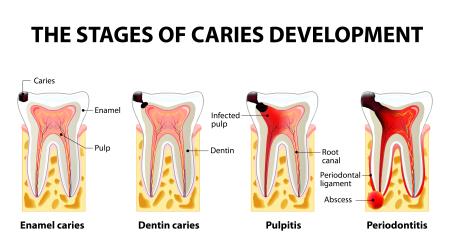Things to Know about Tooth Abscess
Tooth abscess is an oral disease that can cause severe complications without timely treatment. In this article, we’ll discuss the causes of tooth abscess, treatment options, and other essential information.
What is tooth abscess?
Tooth abscess refers to a condition in which the teeth’s roots and gums are attacked by bacteria, resulting in an infection; or when the tartar buildup on the teeth spread down to the gums, causing infection and abscess. This is known as tooth abscess or abscessed tooth.
Tooth abscess causes different levels of pain which may spread to the whole jaws, ears, and neck. If not treated, tooth abscess may become severe, leading to blood infection and even death.
Types of tooth abscess
Depending on the positions of the abscess, tooth abscess may be categorized into 3 major types:
- Periapical abscess: This type of tooth abscess forms at the apex which is the tip of the root. It’s caused by bacteria leaking into the pulp through a small cavity on the crown, resulting in inflammation.
- Periodontal abscess: This is an abscess that develops on the gum, periodontal ligament, and the alveolar bone. It may also be caused by physical trauma. Without timely treatment, a periodontal abscess may spread to adjacent tissues and bones.
- Gingival abscess: Gingival abscess occurs when the gums surrounding the root is inflamed, causing the gums to swell up and develop pus. This may happen if a piece of fish bone, the hull of a corn kernel, or a toothbrush bristle get lodged in the gum. Other causes include the habit of using toothpicks or improper use of floss resulting in gum damage.
Learn about: What You Need to Know About Gum Disease
Symptoms of tooth abscess
The main symptom of tooth abscess is piercing pain occurring in the root and surrounding gums. Pain caused by tooth abscess often strikes out of the blue and worsens with time.
Other symptoms include:
- Pain that radiates to your jaw, ear or neck
- Pain that gets worse when you lie on the side with the abscessed tooth
- Severe pain when chewing or biting
- Facial redness and swelling on the side with the abscessed tooth
- Gums that are swollen, red, soft, and feel hotter than other areas
- Tooth sensitivity
- The abscessed tooth appears to have risen higher than the rest
- Discolored or loose teeth
- Bad breath, metallic taste in the mouth
- Tender or swollen lymph nodes in your neck or under your jaw
- Fever.
If an abscess ruptures, you’ll feel like you pain immediately gets better, almost relieved. You might also notice the metallic taste of blood and salty taste of pus flooding your mouth.
Causes of tooth abscess

Tooth abscess is caused by the invasion of bacteria into the pulp or the gum, leading to inflammation and pus formation. Besides, other factors also contribute to your risk of tooth abscess:
- Poor oral hygiene: Improper oral care, such as not brushing your teeth twice per day and not using dental floss to clean the gaps between teeth may increase your risk of cavities, gum disease, tooth abscess, and other oral complications.
- Excessive consumption of sugar: If you favor sugary foods and beverages such as sweets and soft drinks, you are at an increased risk of cavities and eventually, tooth abscess.
- Dry mouth: Dry mouth is a risk factor of cavities. It’s a common side effect of certain medications and a normal part of aging.
Treatment options for tooth abscess
To treat an abscessed tooth, dentists often focus on cleaning up the infected site and manage pain. Depending on your symptoms, your dentist might start with a dental X-ray to determine whether the infection has spread to other areas and come up with a timely treatment option.
Recommended treatment options for tooth abscess include:
- Draining the abscess: Your dentist will make a small incision into the abscessed root for pus drainage. They’ll follow up by cleaning the inflamed area to prevent the infection from spreading.
- A root canal procedure: The pulp is the innermost soft part of a tooth. It is the house of connective tissues, blood vessels, and nerves. Your dentist will do a root canal to keep the teeth with cavities or abscess. The procedure involves drilling into the affected teeth to remove the nerves and the pulp. After that, they will clean the inside of your tooth and fill it or put a ceramic crown over it.
- Tooth extraction: If the inflammation has severely damaged your tooth, your dentist will extract your tooth before cleaning up the abscess.
- Antibiotics: If the infection has spread to surrounding areas or your immune system is incapable of fighting on its own, your dentist might prescribe oral antibiotics for you.
- Surgical removal of foreign object: If the cause of your abscess is a foreign object (fishbone, toothbrush bristle, etc.), your dentist will remove it with a minor surgical procedure. Then, they will clean the abscessed area.
If you can’t seek medical help from your dentist at the moment, you can take an NSAID containing ibuprofen (Advil, Motrin) for pain management. Rinsing your mouth with warm salt water may prove to be quite helpful in this case.
Common complications of tooth abscess
It’s important to get professional help when it comes to tooth abscess. Even if it’s already ruptured, you still need to check with your dentist to make sure the infection doesn’t spread.
Left untreated, the infection can spread to your jaw bone, head, neck, and even your brain. In rare cases, it can even lead to blood infection, a life-threatening complication.
Go to a hospital or a reputable dental clinic as soon as possible if you have tooth abscess and:
- High fever
- Swollen face
- Swallowing problem
- Rapid heart rate
- Confusion or disorientation
These are the warning signs of a serious infection developing in your abscessed tooth which requires emergency treatment.
Fortunately, you can totally lower your risk of tooth abscess by frequently practicing good oral hygiene, changing your toothbrush after every 3 months, using an antibacterial mouth rinse, etc. Most importantly, don’t forget to visit your dentist every 6 months. To healthy and radiant teeth!
You can have a look at our dental treatment cost guide or contact us for further information.
Reference source
Services
Working Time
- Monday - Friday: 08:00 - 19:00
- Saturday: 08:00 - 18:00
- Sunday closed
Contact Info
- Hotline 1: (+84) 908 321 455
- Hotline 2: (+84) 931 857 885
- Mobile: (+84) 8 3925 8778
- Phone: (+84)2 838 258 778
- info@dentalrose.net
- rosedentalclinicvn@gmail.com
 English
English  Tiếng Việt
Tiếng Việt

